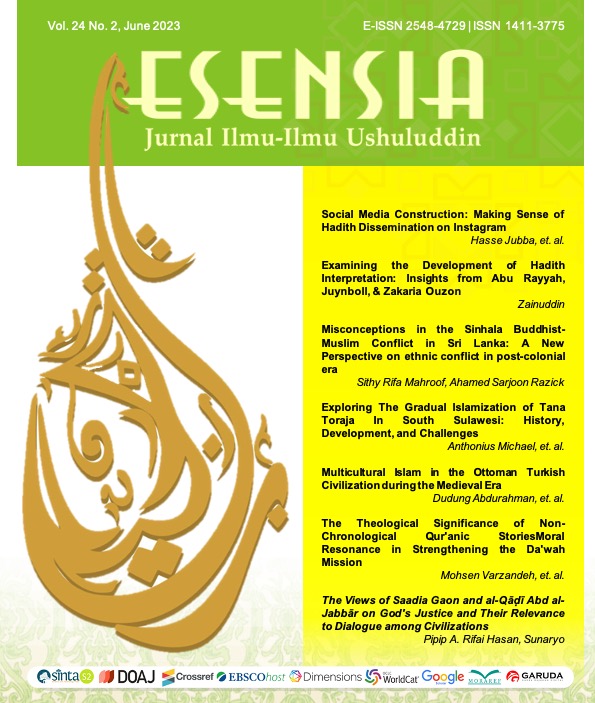Exploring The Gradual Islamization of Tana Toraja in South Sulawesi History, Development, and Challenges
Main Article Content
Abstract
The profound journey of Islam's expansion in South Sulawesi during the 15th century resulted in a gradual uptake of Islam within the Toraja region. This delayed acceptance, compared to other areas in South Sulawesi, is frequently attributed to the use of force during Islam's expansion. This perception highlights the challenge of promoting tolerance between the Muslim minority and Christian majority in the region. To understand the complexities of this phenomenon, this study seeks to explore factors beyond violence that contributed to the slow pace of Islamization. Employing a qualitative approach based in anthropology, the research delves into historical and cultural contexts. It finds that forceful Islamization efforts by figures like the Bone Kingdom, Kahar Muzakkar, and Andi Sose, actually hampered the spread of Islam due to the negative cultural impacts they created. Instead, it was the migration of Muslims to Toraja for trade that played a key role in introducing Islam to the region. Intermarriages further altered the dynamics, shifting Islamization from a conversion-focused approach to one based on family connections. This had consequences for how Islamic communities developed, depending on the choices of second-generation Muslims. The slow pace of Islamization also influenced various aspects of social and religious life, leading the Toraja people to develop nuanced responses. They managed change by emphasizing positive aspects of Islam while minimizing negative ones, aiming to maintain peace within their religiously diverse society. Thus, the Toraja actively engaged in managing the evolving religious landscape, adapting their practices to maintain communal harmony.
Article Details

This work is licensed under a Creative Commons Attribution-NonCommercial-ShareAlike 4.0 International License.
References
Abdullah, Muh Ruslan, and Muh. Rasbi. “The Forming Factors of Religious Moderation and Islamic Happiness of The Muslim Minority in Tana Toraja.” Al-Qalam 29, no. 2 (November 28, 2023). https://doi.org/10.31969/alq.v29i2.1331.
Adams, Kathleen M. Art as Politics : Re-Crafting Identities, Tourism, and Power in Tana Toraja, Indonesia. Honolulu: University of Hawaii Press, 2006.
Alsa, Asmadi. Pendekatan Kuantitatif Dan Kualitatif Serta Kombinasinya Dalam Penelitian Psikologi. Jakarta: Pustaka Pelajar, 2014.
Baturante, Nurdin. Toraja, Tongkonan Dan Kerukunan. Makassar: Pustaka Al-Zikra, 2019.
Beyer, Peter. “Religious Identity and Educational Attainment among Recent Immigrants to Canada: Gender, Age, and 2nd Generation.” Journal of International Migration and Integration / Revue de l’integration et de La Migration Internationale 6, no. 2 (March 2005): 177–99. https://doi.org/10.1007/s12134-005-1009-2.
Bigalke, Terance W. Tana Toraja: A Social History of an Indonesian People. Singapore: Singapore University Press, 2005.
Budiman, Michaela. Contemporary Funeral Rituals of Sa’dan Toraja: From Aluk Todolo to “New” Religions. Prague: Karolinum Press, 2013.
Buijs, Kees. Powers of Blessing from the Wilderness and From Heaven: Structure and Tranformations in the Religion of the Toraja in The Mamasa Area of South Sulawesi. Leiden: KITLV Press, 2006.
Courbage, Youssef, and Emmanuel Todd. A Convergence of Civilizations: The Transformation of Muslim Societies Around the World. Translated by George Holock. New York: Columbia University Press, 2011.
Dragojlovic, Ana, and Annemarie Samuels. “Tracing Silences: Towards an Anthropology of the Unspoken and Unspeakable.” History and Anthropology 32, no. 4 (August 8, 2021): 417–25. https://doi.org/10.1080/02757206.2021.1954634.
Eller, Jack D. Introducing Anthropology of Religion Culture to the Ultimate. Oxfordshire: Taylor & Francis, 2007.
Fargues, Philippe. “Demographic Islamization: Non-Muslims in Muslim Countries.” SAIS Review 21, no. 2 (2001): 103–16.
———. “The Arab Christians of the Middle East: A Demographic Perspective.” In Christians Communities in the Arab Middle East: The Challenge of the Future, edited by Andrea Pacini. Oxford: Clarendon Press, 1998.
Graaf, H.J. De. “South in Asian Islam to the Eighteenth Century.” In History of Islam, edited by P.M. Holf, Vol. 2. London: The Cambridge University Press, 1970.
Haryanto, Sindung. “The Sociological Context of Religion in Indonesia.” In Research in the Social Scientific Study of Religion, Volume 30, edited by Ralph W. Hood and Sariya Cheruvallil-Contractor, 67–102. Leiden: Brill, 2019. https://doi.org/10.1163/9789004416987_006.
Ilyas, Husnul Fahimah. Lontaraq Suqkuna Wajo: Telaah Ulang Awal Islamisasi Di Wajo. Tangerang: LSIP, 2011.
Jong, Edwin de. Making a Living between Crises and Ceremonies in Tana Toraja: The Practice of Everyday Life of a South Sulawesi Highland Community in Indonesia. Leiden: Brill, 2013.
Michael, Anthonius, Fatimah Husein, and Siswanto Masruri. “Acculturation of Mosque and Church in Indonesia: Case Studies from Toraja.” Afkaruna: Indonesian Interdisciplinary Journal of Islamic Studies 19, no. 1 (July 1, 2023). https://doi.org/10.18196/afkaruna.v19i1.16850.
Moleong, Lexy J. Metodologi Penelitian Kualitatif. Bandung: Remaja Karya, 1989.
Nooy-Palm, Hetty. The Sa’dan-Toraja: A Study of Their Social Life and Religion. Dordrecht: Springer Netherlands, 1979. https://doi.org/10.1007/978-94-017-7150-4.
Pelras, Christian. “Religion, Tradition, and the Dynamics of Islamization in South Sulawesi.” Archipel 29, 1983.
Radjab, Mansyur, Arsyad Genda, Andi Haris, and Suparman Abdullah. “Religious Tolerance Practices: A Case Study of Family With Different Religions in Toraja Ethnicity South Sulawesi Province, Indonesia,” 2020. https://papers.ssrn.com/abstract=3632700.
Rerung, Alvary Exan. “Nilai Hospitalitas Budaya Raputallang Sebagai Upaya Gereja Dalam Moderasi Beragama Pada Relasi Islam-Kristen Di Toraja.” Skenoo : Jurnal Teologi Dan Pendidikan Agama Kristen 2, no. 2 (December 28, 2022): 102–12. https://doi.org/10.55649/skenoo.v2i2.34.
Risfaisal, Risfaisal, and Eliza Meiyani. “History And Da’wah of Muhammadiyah in The Muslim Minority Area of Tana Toraja Regency.” International Journal Ihya’ ’Ulum Al-Din 24, no. 2 (December 28, 2022): 105–13. https://doi.org/10.21580/ihya.24.2.11126.
Salmiati, Lismawati, Nurlina Jalil, and Nurpayani. “Eksistensi Pendidikan Islam Di Lingkungan Minoritas Muslim: Studi Kasus Di Lembang Sereale, Toraja Utara.” Al-Musannif 5, no. 2 (2023): 109–24. https://doi.org/https://doi.org/10.56324/al-musannif.v5i2.110.
Samuels, Annemarie. “‘This Path Is Full of Thorns’: Narrative, Subjunctivity, and HIV in Indonesia.” Ethos 46, no. 1 (March 5, 2018): 95–114. https://doi.org/10.1111/etho.12194.
Sewang, Ahmad M. Islamisasi Kerajaan Gowa (Abad XVI Sampai Abad XVII). Jakarta: Yayasan Obor Indonesia, 2005.
Steedly, Mary. A Story of Indonesian Independence. Berkeley: University of California Press, 2013.
Sugiyono. Metode Penelitian Combinasi. Bandung: Alfabeta, 2012.
Verdery, Ashton M. “Links Between Demographic and Kinship Transitions.” Population and Development Review 41, no. 3 (September 15, 2015): 465–84. https://doi.org/10.1111/j.1728-4457.2015.00068.x.
Volkman, Toby A. “Visions and Revisions: Toraja Culture and the Tourist Gaze.” American Ethnologist 17, no. 1 (February 28, 1990): 91–110. https://doi.org/10.1525/ae.1990.17.1.02a00060.
Waterson, Roxana. Paths and Rivers: Sa’dan Toraja Society in Tranformation. Leiden: KITLV Press, 2009.

